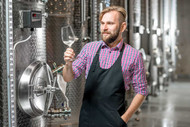So, you’ve learned about non-alcoholic wine. You may have heard about friends trying it, seen advertisements or even had a few sips yourself. Maybe you’re an expecting mother who just doesn’t want to give up that delicious wine flavor you love so much. Maybe, you just don’t enjoy the taste of alcohol.
Whatever your reasons are, you’re interested in learning more about this non-alcoholic wine craze. What exactly is alcohol-free wine? Doesn’t that just mean grape juice? Fortunately, we have the answers you’re looking for. We’ve compiled a list of everything you should know about non-alcoholic wine.
First, what exactly is non-alcoholic wine? Is it the same as alcohol-free or dealcoholized? Yes. All three of these terms can be used pretty interchangeably when referring to wine or beverages which have had the alcohol removed. Though the terms can have slightly different meanings depending on what they refer to and what country you are in, non-alcoholic, alcohol-free and dealcoholized all mean there is little to no alcohol in the wine—0.0% alcohol by volume.
“ ...making alcohol-free wine isn’t very different from making regular wine.”
Now, if you take the alcohol out of wine, doesn’t that make it grape juice? Actually no, it’s a bit more complicated than that. In fact, making alcohol-free wine isn’t very different from making regular wine. First, grapes are harvested from the vineyard, either by human hands or by machine. The moment the grapes are picked determines the acidity, sweetness and flavor of the wine. Once the grapes are harvested, they are taken to the winery and sorted into bunches, with rotten or under-ripe grapes removed.
Then, the grapes are run through a destemmer, then crushed by a mechanical press, which increases the sanitation quality and longevity of the wine. This is where white wines and red wines differ. For white wines, the grapes are quickly crushed and pressed in order to separate the juice from the skins, seeds and solids. This prevents any unwanted color or tannins from leaching into the wine. Grapes for red wines, however, are left in contact with their skins in order to acquire more flavor, color and additional tannins, which help make the wine dry and bitter.
Next is the fermentation process. Fermentation is when sugars in the grape juice are converted into alcohol. The juice can begin fermenting naturally within 6-12 hours when wild yeasts are in the air; however, most winemakers intervene and add a commercial yeast to ensure consistency. Fermentation continues until all of the sugar is converted into alcohol. For sweeter wines, winemakers will stop the process before all the sugar converts. Depending on the wine, the fermentation process can last anywhere from 10 days to one month or more.
Non-alcoholic wine even goes through an aging process like regular wine. This process all depends on the kind of wine the winemaker wishes to produce. Aging intensifies the flavors in the wine, and can be done in a variety of different ways: from bottles, to stainless steel tanks to oak barrels. The type of aging and how long it takes influences the quality and taste of the wine produced. Some white wines only need a few months to age, while many dry red wines need to be aged for 18-24 months before the bottling process begins.
“ ...non-alcoholic wine [is] much less sugary than grape juice, but [has] the same great flavors and complexity as wine that contains alcohol.”
This is where non-alcoholic wine differs from say, grape juice. While grape juice is the unfermented juice sourced from grapes, non-alcoholic wine goes through the same fermentation and aging process as regular wine, only to have the alcohol removed at the last stages. This makes non-alcoholic wine much less sugary than grape juice, but with the same great flavors and complexity as wine that contains alcohol.
However, just before the wine is about to be bottled comes the hard part: removing the alcohol from the wine. There are two main ways winemakers go about removing the alcohol: distillation and filtration.
Distillation is the process of distilling the alcohol off the wine through steam. In other words, commercial producers put the wine into an extremely strong vacuum and heat it. As the suction of the vacuum increases, the boiling temperature for the wine decreases. This allows winemakers to heat the wine temperatures as low as 70 degrees Fahrenheit, which distills the alcohol off the wine, without heating the wine too much and causing it to oxidize.
The second method of removing alcohol is through filtration, or reverse osmosis. In this, winemakers use extremely high pressure to force the wine against a membrane so fine only water and alcohol can seep through it. They repeat this process until the wine becomes a concentrate. Water is then added back into the concentrate to create the alcohol-free wine.
Once the alcohol has been removed from the wine, it’s ready for bottling and consumption. Winemaking is a unique and beautiful process, and non-alcoholic winemaking takes the process a step further to make a product that is available to a wider variety of consumers.
While there are many non-alcoholic options available on the market such as juices and sparkling water, we encourage you to give alcohol-free wines a try. You’ll be surprised by the myriad non-alcoholic wines available on the market today, from alcohol-free alternatives to champagne to delightful, light rose wines. Now that you know how non-alcoholic wine is made, give it a try and enjoy the taste for yourself.
This article was reposted from BeClink.com. See the original article.
